Data for 2018
The National Membership Report provides annual information on the provincial and territorial engineering regulators’ membership to deliver timely and accurate information about the engineering profession in Canada. Please find all data tables associated with this report here.
Growth in the engineering profession
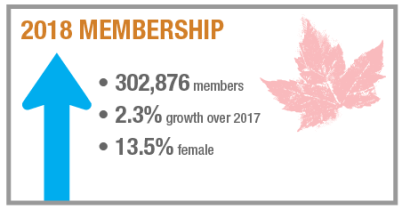 Membership in the provincial and territorial regulators increased from 2017 to 2018. There were 302,876 membersi as of December 31, 2018 across the 12 engineering regulators comprising the national total membership (see Table 1). The largest growth in numbers was seen in Ontario (2,610 engineers), followed by Quebec (1,511), and British Columbia (1,269), while the largest percentage growth of members was seen in the Yukon (11.6% from 951 in 2017 to 1,061 in 2018), followed by the Northwest Territories (7.9% from 1,804 in 2017 to 1,947 in 2018). Total national membership for 2018 increased by 2.3 per cent, members who are women increased by 5.5 per cent nationally, and male members increased by 1.9 per cent nationally.
Membership in the provincial and territorial regulators increased from 2017 to 2018. There were 302,876 membersi as of December 31, 2018 across the 12 engineering regulators comprising the national total membership (see Table 1). The largest growth in numbers was seen in Ontario (2,610 engineers), followed by Quebec (1,511), and British Columbia (1,269), while the largest percentage growth of members was seen in the Yukon (11.6% from 951 in 2017 to 1,061 in 2018), followed by the Northwest Territories (7.9% from 1,804 in 2017 to 1,947 in 2018). Total national membership for 2018 increased by 2.3 per cent, members who are women increased by 5.5 per cent nationally, and male members increased by 1.9 per cent nationally.
Members who are women accounted for 41,024 of total national membership representing 13.5 per cent of members in 2018, an increase from 13.1 per cent in 2017.ii The largest growth in members who are women was seen in Ontario, with an increase of 701 members between 2017 and 2018.
Newly licensed engineers
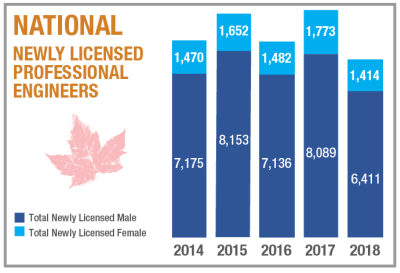 The category, Newly Licensed, includes individuals licensed as professional engineers for the first time that are Canada Engineering Accreditation Board trained, internationally trained, or have obtained their license by some other route. It does not include interprovincial mobility applicants.
The category, Newly Licensed, includes individuals licensed as professional engineers for the first time that are Canada Engineering Accreditation Board trained, internationally trained, or have obtained their license by some other route. It does not include interprovincial mobility applicants.
There were 7,825 newly licensed engineersiii in 2018 with the largest number (2,649 engineers) obtaining their licence in Ontario through Professional Engineers Ontario (PEO) (see Table 2). Nationally however, the number of newly licensed engineers declined by 15.9 per cent between 2017 and 2018, from 9,311 to 7,830. For the five-year trend in newly licensed engineers (2014 to 2018) see Newly Licensed Graph.
30 by 30
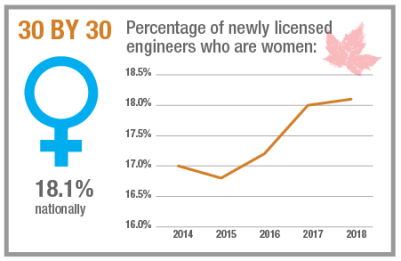 In 2015, Engineers Canada launched the 30 by 30 initiative with support from the provincial and territorial regulators. 30 by 30 is a commitment to increasing the proportion of newly licensed engineers who are women to 30 per cent by 2030. Women accounted for 18.1 per cent of newly licensed engineers in Canada for the year 2018 (see 30 by 30 and Newly Licensed Graph). A total of 1,414 women obtained their licence in 2018 in Canada. The largest number of newly licensed engineers who are women received their licence in Ontario (471), followed by Quebec (385), and Alberta (238).
In 2015, Engineers Canada launched the 30 by 30 initiative with support from the provincial and territorial regulators. 30 by 30 is a commitment to increasing the proportion of newly licensed engineers who are women to 30 per cent by 2030. Women accounted for 18.1 per cent of newly licensed engineers in Canada for the year 2018 (see 30 by 30 and Newly Licensed Graph). A total of 1,414 women obtained their licence in 2018 in Canada. The largest number of newly licensed engineers who are women received their licence in Ontario (471), followed by Quebec (385), and Alberta (238).
Residency of engineers
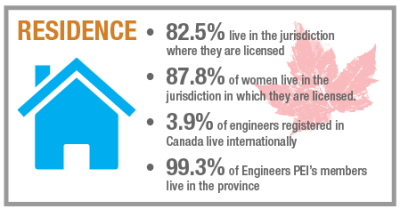 There were 172,391 practising professional engineers licensed in the jurisdiction where they reside. The national percentage of practicing engineers licensed and residing in the jurisdiction where they practice was consistent with previous years at 82.5 per cent (see Table 3). Engineers PEI had the highest percentage of its engineers residing in the province (99.3 per cent), while Engineers Yukon had the lowest (16.5 per cent). The national percentage of engineers licensed and practicing in a Canadian jurisdiction other than where they principally reside was 13.6 per cent. The remaining 3.9 per cent of engineers licensed in Canada lived abroad. Comparing the total number of practicing women and women engineers licensed in the jurisdiction where they reside, women are more slightly likely to reside in the jurisdiction where they practise (87.8 per cent) compared to their male counterparts (81.6 per cent).
There were 172,391 practising professional engineers licensed in the jurisdiction where they reside. The national percentage of practicing engineers licensed and residing in the jurisdiction where they practice was consistent with previous years at 82.5 per cent (see Table 3). Engineers PEI had the highest percentage of its engineers residing in the province (99.3 per cent), while Engineers Yukon had the lowest (16.5 per cent). The national percentage of engineers licensed and practicing in a Canadian jurisdiction other than where they principally reside was 13.6 per cent. The remaining 3.9 per cent of engineers licensed in Canada lived abroad. Comparing the total number of practicing women and women engineers licensed in the jurisdiction where they reside, women are more slightly likely to reside in the jurisdiction where they practise (87.8 per cent) compared to their male counterparts (81.6 per cent).
Engineers per 1,000 people
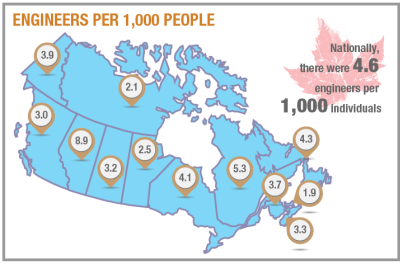 The number of engineers that resided in the jurisdiction where they are licensed per one-thousand peopleiv ranged from 1.9 in Prince Edward Island (PEI) to 8.9 in Alberta. There were 4.6 engineers per one-thousand individuals nationally (see Table 4).
The number of engineers that resided in the jurisdiction where they are licensed per one-thousand peopleiv ranged from 1.9 in Prince Edward Island (PEI) to 8.9 in Alberta. There were 4.6 engineers per one-thousand individuals nationally (see Table 4).
From engineering student to professional engineer
There were 13,808 graduates from accredited post-secondary engineering programs in 2014.v In 2018, there were 5,559 graduates from Canada Engineering Accreditation Board approved programs who obtained their engineering licence, which made up 71 per cent of the total newly licensed engineers in 2018. Assuming it takes approximately four years for a graduate from an accredited engineering program to obtain their professional licence, approximately 40.3 per cent of the 2014 cohort proceeded along the path to licensure and became licensed in 2018. Although this is an estimation, it is an attempt at measuring the successful continuation of engineering students along the path to licensure.
i The category, Members, includes Practising P.Eng.’s (exclusive), Temporary License Holders, License to Practise Holders, Restricted License Holders, Non-Practising P.Eng.’s, Life Members and Engineers-in-Training. It does not include students.
ii Engineers Canada, “2018 National Membership Information,” Table UD.2.1, p. 36, 2018. [Online]. Available: https://engineerscanada.ca/reports/national-membership-report/2018-report. [Accessed July 25, 2019].
iii The category, Newly Licensed, includes individuals licensed as Professional Engineers for the first time that are Canada Engineering Accreditation Board trained, Internationally trained, or have obtained their license by some other route. It does not include interprovincial mobility applicants.
iv Statistics Canada. Table 17-10-0009-01 Population Estimates, quarterly (Q4 2018). (Accessed: June 12, 2019)
v V. Rossi, “Canadian engineers for tomorrow,” Engineers Canada, Ottawa, Canada, n.d., pp. 36. Available: https://engineerscanada.ca/publications/canadian-engineers-for-tomorrow-2017. [Accessed July 25, 2019].
